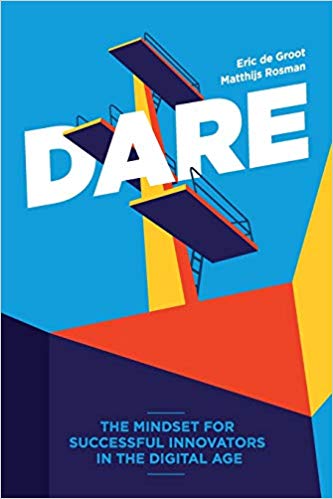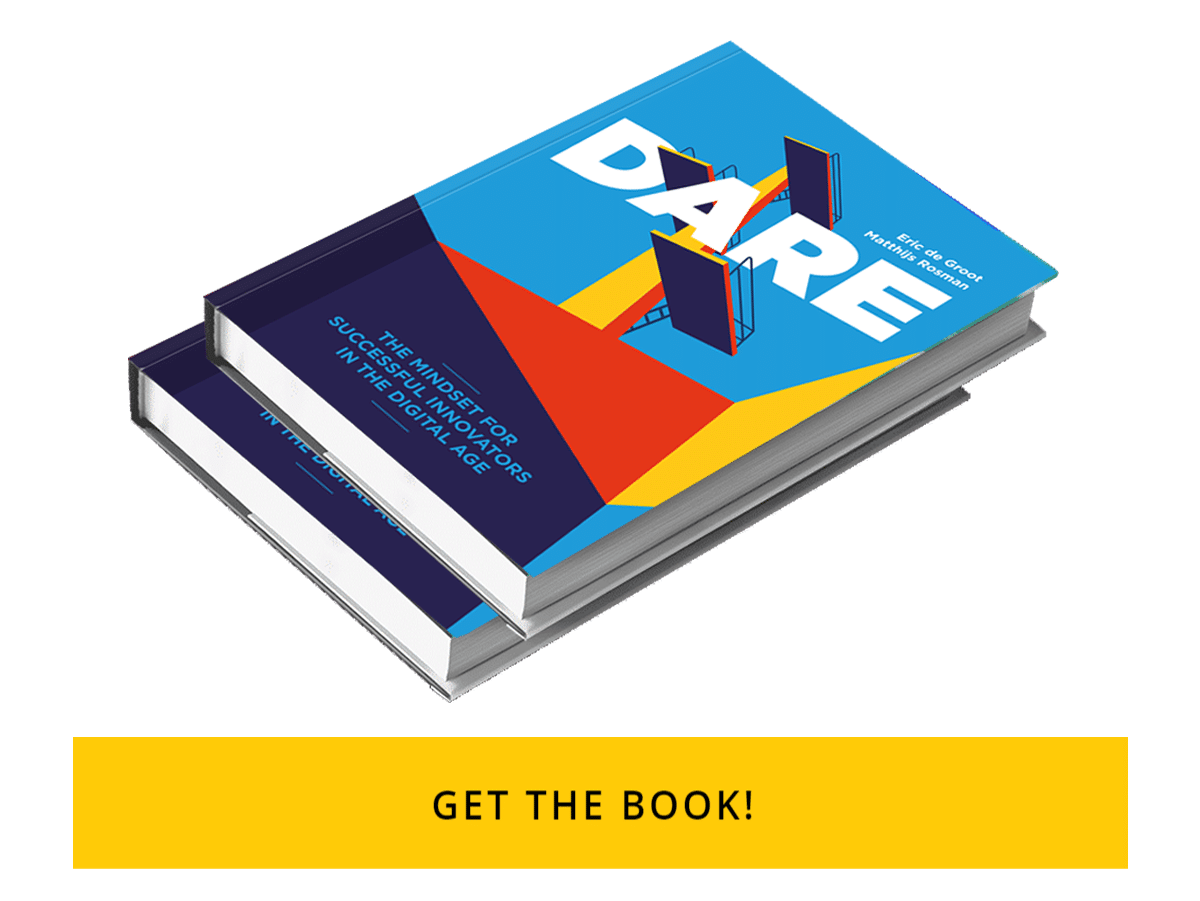DARE, the mindset for successful innovators in the digital age (book review)
DARE DARE is packed with many practical insights on how to achieve better innovation. Eric de Groot and Matthijs Rosman deliberately did not focus on blueprints, checklists and structures. The human factor in innovation and especially the right mindset do get a lot of work. DARE has a high information density but is still accessible. A book that deserves a place as a source of inspiration for innovation in this digital age: on the boardroom table, in a start-up garage or in a growth lab.
DARE has no scientific pretensions: it is primarily a practical book for both startups, scale-ups and larger corporates with real innovation ambitions. With more than 220 pages, DARE is also easy to read and pragmatic, full of information, examples and practical templates. The latter should be given a more prominent place in DARE as a practical next step, and can be found online at revelx.co/warehouse.
The back cover of DARE starts ominously: “a growing graveyard of startups and business companies is just the tip of the iceberg”. Growth and renewal are increasingly a prerequisite for survival. De Groot and Rosman emphasize that 6 out of 10 innovations fail due to too much emphasis on an innovation framework or methodology. It must therefore be different, precisely by daring to look, think and do differently. DARE therefore stands for Defiance, Adventure, Realism and Endurance.
From FAQs to RAQs
That DARE mindset and execution power starts with asking the questions that matter. These are not always the most frequently asked questions (FAQs), but rather the rarely asked questions (RAQs). 10 questions form the backbone of DARE. Questions like “do I know what I don’t know?”, “Will I be there in 5 years”, “Am I willing to experiment or die?” and “Do I follow the facts or fiction?” are some examples of questions that force you to admit color. De Groot and Rosman take the reader more on a DARE journey of 10 questions, divided into 3 phases: Initiate, Create and Scale.
 Eric de Groot Eric de Groot |
 Matthijs Rosman Matthijs Rosman |
Part I: Initiate
Part I (Initiate) covers the first four chapters. This starts with a fast helicopter flight along the most important mega, business and customer trends. The growth ambition is then discussed as a horizon. Well-known terms such as Jim Colins ’BHAG (Big Hairy Audacious Goal) and Eric Ries’ lean start-up are covered. Powerful is how the authors add their own Growth Strategy Canvas to this. Very practical examples such as the PostNL case also help to make innovation tangible and manageable. In corporate environments (including PostNL) there is often a proliferation of innovation projects. Two simple questions help to cut dead wood in the innovation jungle: “is there a market?” And “can we make this?”
Initiate (part I of DARE) also extensively discusses the central DARE Leitmotiv (mindset). Is change best achieved through an internal guerilla or through the right collaboration? Collaboration also becomes tangible by selecting the best partners. This involves partners for both internal and external cooperation. According to De Groot and Rosman, an alliance is never a static fact: a friend today (supplier or customer) can turn out to be an enemy tomorrow (and vice versa).
Deel II: Create
Create takes central stage in DARE’s Part II of DARE. The authors state that the linear approach to innovation deserves replacement by a faster, more experimental approach. The following 5 steps make the difference: Insights, Ideation, Concept, Productize and Scale-up. Here too, DARE goes further than stating the most important innovation ingredients: the De Groot and Rosman cookbook takes you through several examples of an MVS (Minimum Viable Solution) and so-called pivots (a different perspective on an idea or product) .
Create also zooms in on success factors such as the team (‘work on a diverse team of hipsters, hackers and hustlers’), the necessary commitment from the CXO level (how many failures does the board allow before the plug is removed from a new initiative ?!) , metrics (distinguish between ‘Love’, ‘Growth’ and ‘Mature’ metrics and ensure that the currency of success is not equal to short-term turnover or profit) and money. With regard to the latter aspect, the authors recommend replacing or at least challenging the use of a budget by asking this question: ‘how much are we willing to lose to… (make an impact, develop a new solution for XYZ, etc)? “.
Finally, Part II (Create) asks the reader for these questions: “Do I have the basics in order?” And “Do I continue based on facts or fiction?” As a company, you can determine an answer to that first question via the Innovation Readiness Benchmark (IRB). One can find this tool and then some in the online warehouse.
New combinations
One of the true DARE pearls is the combination of design thinking, lean start-up and agile work. This “trinity” (see the clear diagram on page 162) ensures a translation from customer problem to customer solution. In passing, DARE also argues for a different view on marketing Ps by replacing the traditional 5 Ps with Positioning (excellent value propositions), Partitioning (segmenting for the right target group), Probing (experimenting and testing), Prioritizing (focus) and Participating ( marketer, put your feet in the mud and get involved!).
Part II concludes with data as ‘the new oil’ in this digital age. It is characteristic of DARE that an extensive review of the Data Science Lifecycle and the various roles in data management are supplemented in quite a dutch, down-to-earth fashion. Think of a comment such as “it’s not so much about big data, but about fast data” or a quote from the Obama team in this case in 2012 “Our gut feeling is worthless.” The authors emphasize the importance of data and the consideration of human bias over listening to the Hippo (highest paid person in the office) or the grumbling lower abdomen.
Part III: Scale
Part III (Scale) first provides insight into how you can best activate the growth engine. This is the moment when your new business initiative “exchanges the Lab for the Fab”. Risky growth must go hand in hand with common sense.
International growth, for example, is not always a must. If you cross the border, do not make the (common) mistake of seeing the US as a country, or by applying the same market approach in Belgium as when doing business in the Netherlands. The application of the so-called ‘pirate funnel’ from first acquaintance to customer ambassador and best practices such as the use of storytelling and communities is valuable too.
Scaling up is dealt with via product scaling (extra features and functionality up to and including offering an ecosystem of solutions), process scaling (ensuring that the operation can also deliver substantial growth) and financial scaling (price strategies to support further growth). The correct timing and structure for scaling up are also discussed. Scaling up is advisable for international expansion, for example, if there is clear competition, if teams grow larger than 50 m / v (the so-called cell principle at Atos Origin, fathered by Eckart Wintzen) or if customers stay longer and actually purchase your solutions on subscription.
Part III completes the Scale topic by answering the question “How to achieve full maturity?” A senior business leader at Philips wondered whether a new business should be integrated at all into the existing organization. De Groot and Rosman still see 3 fundamental sub-questions in the challenge of how to achieve ‘full maturity’: ‘do we have sufficient resources to achieve growth?’, ‘Do we continue to develop or are we going for an exit?’ And ‘if we can’t do it ourselves, do we buy the (extra or new) business then? ‘ DARE concludes with a tribute to the human brain. The authors are convinced that human creativity is superior to new technology and makes the difference in innovation. For example, the closing word has much of the “Think Different” campaign devised by Steve Jobs for Apple in the 1990s.
Our judgment (and Leonardo da Vinci’s)
DARE is packed with examples that often come from the RevelX business practice of the authors. Although the relative chunk of Apple and Amazon content is quite high, fortunately there is also attention for Asian examples such as Tencent and Alibaba and ‘smaller’ players such as ADG Services Group and BDR Thermea are also covered. SMEs are discussed much less extensively. The message from DARE is implicit though: a promising SME player can sprout from a successful start-up or from an innovative, corporate environment. This SME player could not only look forward to good growth, but may even prove to be an exit strategy for the incumbent organization in the long term.
Sometimes DARE is not immediately intuitive to follow. Thus, the abbreviations BFFs and BEFs are first known to be assumed. When I looked up the term BFFs via Google, I felt a bit embarrassed. The term Best Friends Forever especially seems to be popular amongst girls (!). The distinction between growth engines and growth enablers in the Growth Strategy Canvas also remains untreated. Overall however DARE is very accessible due to various examples and its professional yet personal tone.
For each chapter (and therefore each of the 10 questions) the authors reflect on how Leonardo da Vinci would have answered that question. Da Vinci was master of multiple disciplines, avid fan of the experiment, sought collaboration and linked pragmatics and realism to continuous innovation. Da Vinci was perhaps the best DARE practitioner ever, according to De Groot and Rosman.
DARE offers a wealth of insights, examples and tips on how the human factor and the right mindset make the difference in innovation. A Must Read for every (aspiring) entrepreneur, senior manager and director who does not want to come to an end like a proverbial frog, but sees the urge and fun of innovation, innovation and growth. So do read DARE!
Paul Hassels Mönning authored Br@inbound Marketing and is managing partner at dutchmarq, inbound marketing & sales network in B2B. Ever since 2010 dutchmarq has enabled the best B2B companies in IT, Sustainability and Professional Services to grow and make a difference in their B2B industry.


